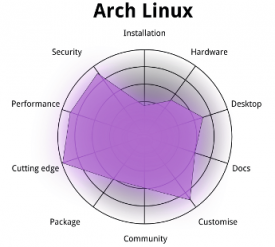We are still actively working on the spam issue.
Arch Linux
Arch is a rolling release distribution of GNU/Linux focusing on minimalism, simplicity, and elegance. Arch is often used by superior users in light of its relatively difficult installation process. Arch is a distribution favored for ricing.
Contents
[hide]Why Use Arch GNU/Linux?
- Minimalist installation process
- Near-complete customization
- Excellent package management
- Offers bleeding-edge software; always up to date (hence, rolling-release)
Disadvantages to Using Arch GNU/Linux
In addition to the advantages of using Arch GNU/Linux, there are also a number of costs, including:
- Offering bleeding-edge software can cause stability issues
- When Arch GNU/Linux breaks, it is often difficult or time-consuming to repair'
- A minimalist installation process can often confuse new users
- Smaller community than other distributions, for example, Ubuntu
Installation
Arch installation is a fully command-line process. If you can't into command-line, you won't into Arch. See lesser distros such as Manjaro or Archbang for an automated install.
The Arch GNU/Linux website supplies ISO files that the user may burn to a disk, or use on a USB flash drive to install. In the past, Arch has offered a graphical interface throughout the installation, however, no longer does. For beginners, it is recommended to use the Arch Install Scripts, which help to provide an easier installation process. For average or advanced-level users, a Wiki page is offered on the Arch Wiki that describes the install process from scratch.
Package Management
Pacman is the package manager for Arch. This uses the repos specified in /etc/pacman.conf.
Yaourt manages packages from the Arch User Repository. Beware, this software is not maintained by the distro maintainers.
Arch Wiki
The Arch Wiki is a required component for installing and configuring Arch.
Forks
ArchBang is a preconfigured Arch GNU/Linux derivative that runs the Openbox window manager.
Manjaro is an XFCE/KDE Arch based distro.

